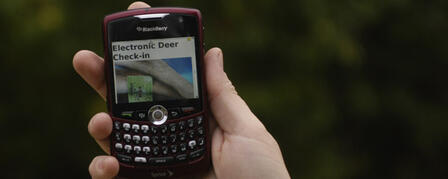ELECTRONIC REGISTRATION OF DEER AVAILABLE

November 8, 2012
Registration number allows hunters to process deer in the field
PRATT — Nearly 100,000 hunters will pursue deer in Kansas this fall, and those numbers will peak from now through early December. The archery season is open, and November is the most popular month with bowhunters. The regular firearm season is Nov. 28-Dec. 9. One important regulation hunters should be aware of is deer must be tagged before being moved from the site of the kill. Unless a hunter has an either-sex permit, the head must remain attached to the carcass while in transit to a residence or place of commercial processing or preservation. However, the agency does offer a voluntary option for transporting harvested deer that allows hunters to register their deer through the Internet, using photos taken at the harvest site. Once registered, the hunter may then transport the carcass without the head attached. If Internet access is unavailable at the kill site, the hunter can retain the photographs while in transit and a registration number can be obtained later. To access the electronic deer check-in, go online to the KDWPT website, www.ksoutdoors.com, and click “Hunting/Big Game/Deer/Deer Check-in.”
This is not a telephone registration system and it is not required.
The hunter is walked through the registration process and given the necessary instructions. The registration process requires the hunter to submit two digital photographs — one close-up clearly showing the completed tag attached to the deer and a second showing the entire body of the deer with the head still attached. Once logged on to the KDWPT website, a hunter must submit the photos and enter the KDWPT number from their permit, time and date of the kill and the county where the deer was taken. A confirmation number will be issued by email when the photos and data are successfully received. This confirmation number must be retained during transportation.
Once these steps are completed, the deer head may be removed and the carcass prepared for transportation. The system allows KDWPT staff to see the deer and the hunter’s completed tag without the time and expense of maintaining a check station. This flexibility is a benefit to both the hunter and KDWPT.
This option was developed to address two important issues regarding deer carcass transportation. The first concern is about the movement of any material from a deer that may contribute to the transmission of chronic wasting disease (CWD). It is believed that spread of CWD could be diminished if certain body parts affected by the disease are not moved from the site where the deer is taken. Because CWD affects the brain and central nervous system, the transportation of a deer head and skeleton from one location to another is considered a likely means for the disease to spread. The new registration system allows a hunter to leave these items at the kill site, minimizing the possibility of spreading CWD.
The second concern is directly related to the first. Many states have adopted strict regulations to prevent the spread of CWD. Typically, these regulations do not allow the transportation of a deer head with brain tissue from a state with confirmed CWD cases. Hunters have been cited in other states and their deer confiscated for not complying with the transportation laws of that state. The new registration system allows a hunter to properly dispose of the head and legally transport the boned meat, as well as the cleaned skull cap and antlers, to the hunter’s home.
More information on CWD and transportation laws may be found on the KDWPT website, www.ksoutdoors.com under “Hunting/Big Game/Chronic Wasting Disease.”
-30-









